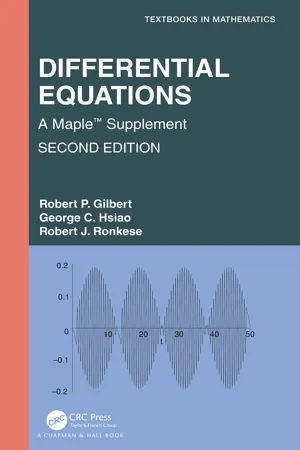
This is a test
- 248 pages
- English
- ePUB (mobile friendly)
- Available on iOS & Android
eBook - ePub
Differential Equations
Book details
Book preview
Table of contents
Citations
About This Book
This book illustrates how MAPLE™ can be used to supplement a standard, elementary text in ordinary and partial differential equation. The authors are firm believers in the teaching of mathematics as an experimental science where the student does numerous calculations and then synthesizes these experiments into a general theory. The goal of the book is to teach the students enough about the computer algebra system MAPLE™ so that it can be used in an investigative way. This book was developed through ten years of instruction in the differential equations course.
Frequently asked questions
At the moment all of our mobile-responsive ePub books are available to download via the app. Most of our PDFs are also available to download and we're working on making the final remaining ones downloadable now. Learn more here.
Both plans give you full access to the library and all of Perlego’s features. The only differences are the price and subscription period: With the annual plan you’ll save around 30% compared to 12 months on the monthly plan.
We are an online textbook subscription service, where you can get access to an entire online library for less than the price of a single book per month. With over 1 million books across 1000+ topics, we’ve got you covered! Learn more here.
Look out for the read-aloud symbol on your next book to see if you can listen to it. The read-aloud tool reads text aloud for you, highlighting the text as it is being read. You can pause it, speed it up and slow it down. Learn more here.
Yes, you can access Differential Equations by Robert P. Gilbert, George C. Hsiao, Robert J. Ronkese in PDF and/or ePUB format, as well as other popular books in Mathematics & Differential Equations. We have over one million books available in our catalogue for you to explore.
Information
Chapter 1
Introduction to the Maple DEtools
The purpose of this chapter is to introduce some Maple features specially related to differential equations. In some instances Maple can find an analytical expression for the solution of an ordinary differential equation (ODE). For this purpose we need to introduce certain syntax which will be given in this chapter.
1.1 Analytical Solutions and Their Plotting
Let us consider the first-order differential equation,
(E)
To obtain the general solution for a particular form of the above equation, we first load
DEtools as follows:> with(DEtools):Let us chose the right-hand side of the above equation 1 as
> f:=2*x*y(x)+x;The syntax for entering and solving the differential equation with this right-hand-side are then given as
> deq:=diff(y(x),x)=f;> gsoln:=dsolve(deq,y(x));__________________________
1Notice that Maple requires the unknown function to be inputted as
To plot the solutions all parameters must be given as floating point numerical values. First we must load
plots. Notice that the use of the colon at the end of the input line suppresses the output from this line.> with(plots):For ODEs with side conditions, such as an initial value condition, abreviated as (IVC), one first defines the condition as
> ic:=y(0)=y0;> soln:=dsolve(deq...Table of contents
- Cover
- Half Title
- Series Page
- Title Page
- Copyright Page
- Contents
- 1 Introduction to the Maple DEtools
- 2 First-Order Differential Equations
- 3 Numerical Methods for First-Order Equations
- 4 Differential Equations with Constant Coefficients
- 5 Applications of Second-Order Linear Equations
- 6 Two-Point Boundary Value Problems, Catalytic Reactors and Boundary-Layer Phenomena
- 7 Eigenvalue Problems
- 8 Power Series Methods for Solving Differential Equations
- 9 Nonlinear Autonomous Systems
- 10 Integral Transforms
- 11 Partial Differential Equations
- 12 Transmutations
- Bibliography
- Index